new posts in all blogs
Viewing: Blog Posts Tagged with: This One Summer, Most Recent at Top [Help]
Results 1 - 7 of 7
How to use this Page
You are viewing the most recent posts tagged with the words: This One Summer in the JacketFlap blog reader. What is a tag? Think of a tag as a keyword or category label. Tags can both help you find posts on JacketFlap.com as well as provide an easy way for you to "remember" and classify posts for later recall. Try adding a tag yourself by clicking "Add a tag" below a post's header. Scroll down through the list of Recent Posts in the left column and click on a post title that sounds interesting. You can view all posts from a specific blog by clicking the Blog name in the right column, or you can click a 'More Posts from this Blog' link in any individual post.

By: Samantha McGinnis,
on 5/17/2016
Blog:
First Book
(
Login to Add to MyJacketFlap)
JacketFlap tags:
graphic novels,
Book Lists,
science,
Caldecott,
The Liberation of Gabriel King,
Loree Griffin Burns,
summer reads,
Citizen Scientists,
Mariko Tamaki,
Deborah Underwood,
Johanna Kerby,
A Balloon for Isabel,
graduation gifts,
This One Summer,
Inside First Book,
Our Recommendations,
K.L.Going,
Little Pink Pup,
Add a tag
The school year is coming to a close and it’s time to stock up for summer reading. We have five great books for you!
This month, our book list features a sweet story about an unconventional animal family, an adorable picture book that celebrates determination, a nonfiction guide to becoming a backyard scientist, and a book that teaches you how to stand up to their fears. For mature readers, the first-ever graphic novel to receive a Caldecott Honor will make for an engrossing read.
For Pre-K –K (Ages 3-6):
 Little Pink Pup by Johanna Kerby
Little Pink Pup by Johanna Kerby
Get ready to say “Awww!” every time you turn the page! The real-life photos of a tiny little pig being raised by dachshunds is a heart-warming story that promotes acceptance and reminds us that everyone deserves love.
For 1st and 2nd Grade (Ages 6-8):
 A Balloon for Isabel by Deborah Underwood
A Balloon for Isabel by Deborah Underwood
This adorable picture book is both a perfect read-aloud and an ideal graduation gift! It’s a joyful celebration of creativity, determination, and creative problem-solving. We can’t get enough of this one!
For 3rd & 4th grade (Ages 8-10):
 Citizen Scientists by Loree Griffin Burns
Citizen Scientists by Loree Griffin Burns
Anyone can be a scientist in this kid-friendly, non-fiction gem! Kids will learn how to observe, conduct research, collect data, and be part of four unique scientific discoveries that can happen anywhere — in a backyard, a field, or even a city park.
For 5thand 6th Grade (Ages 10-12):
 The Liberation of Gabriel King by K.L. Going
The Liberation of Gabriel King by K.L. Going
Warm, wonderful, and unforgettable, this is the terrific story of a boy whose best friend teaches him to stand up to his fears – from spiders to bullies and more. A perfect read for summer!
Grades 7 & up (Ages 13+):
 This One Summer by Mariko Tamaki
This One Summer by Mariko Tamaki
Both hopeful and heartbreaking, this beautiful book is the first graphic novel to be awarded a Caldecott Honor. Mature teens will find it captivating and will readily relate to its coming-of-age explorations of complex friendship and family relationships.
The post Monthly Book List: Our Favorite Books For May appeared first on First Book Blog.


By:
Heidi MacDonald,
on 3/29/2016
Blog:
PW -The Beat
(
Login to Add to MyJacketFlap)
JacketFlap tags:
CBLDF,
the new yorker,
Alison Bechdel,
persepolis,
Marjane Satrapi,
Kickstarter,
this one summer,
Kickstarter Spotlight,
She Changed Comics,
Add a tag
Frankly, we need this book.
Here we go again. A parent in Seminole County, Fla. found that her nine year old brought home This One Summer by Mariko Tamaki and Jillian Tamaki and thought it was way too adult for her kid and complained, and the local TV news has launched an investigation and discovered that shockingly, the book, which […]

By:
Heidi MacDonald,
on 7/17/2015
Blog:
PW -The Beat
(
Login to Add to MyJacketFlap)
JacketFlap tags:
Graphic Novels,
Graphic Novel,
Comics,
Conventions,
First Second,
comic,
San Diego,
comic-con,
mariko tamaki,
Top News,
Top Comics,
SDCC '15,
this one summer,
Interviews,
Add a tag
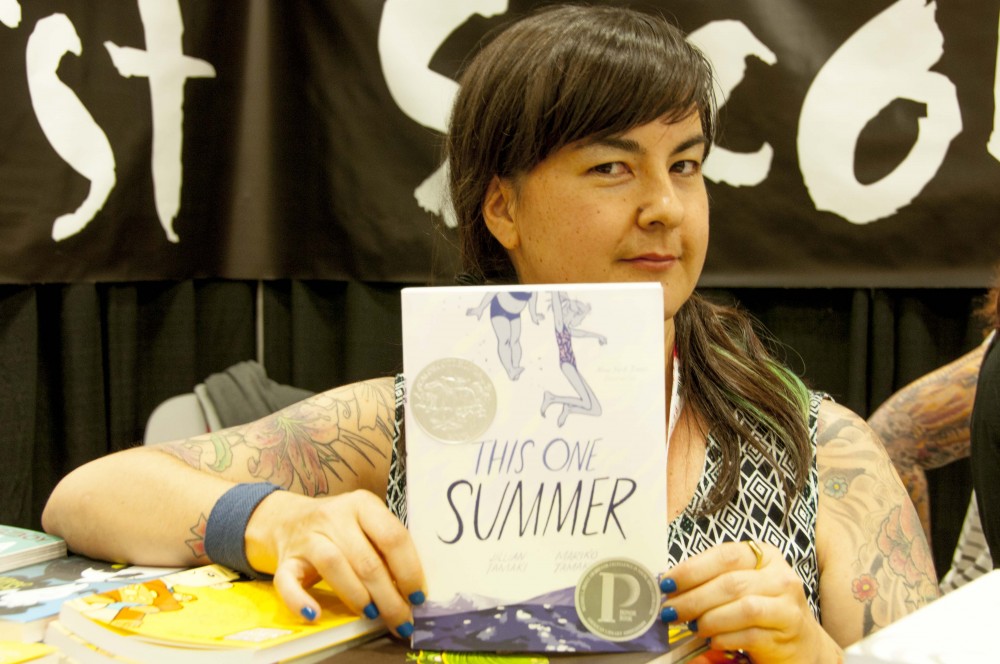
Mariko Tamaki
By Nick Eskey
Mariko Tamaki is a Canadian born artist of mixed Japanese and Jewish descent. In school she studied literature and writing, later on publishing the book “Cover Me,” as well as graphic novels “Skim” and “Emiko Superstar.” Her recent work is another graphic novel entitled “This One Summer.” Jillian Tamaki, Mariko’s cousin, did the illustrations for both this novel and for “Skim.”
“This One Summer” gives a glimpse into the life of two young girls as they spend one summer at a cottage by the beach. We get to see them learn and experience new things, as well as see the contrast between lives of adults and kids. During this year’s San Diego Comic-Con, I got to sit down and talk about this book with writer Mariko Tamaki. Unfortunately, Jillian could not attend.
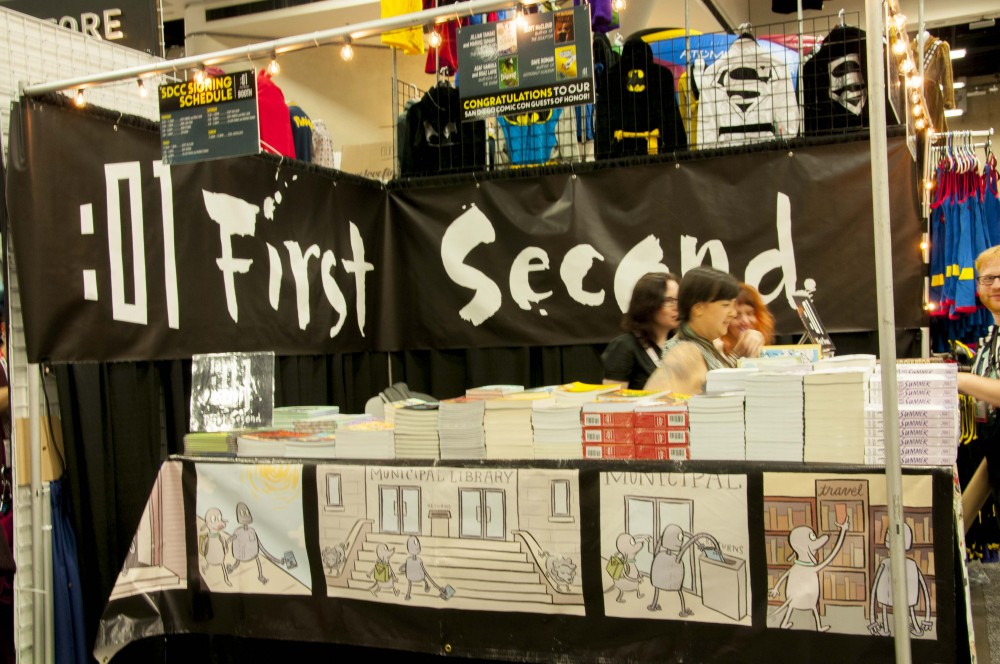
The First Second booth at San Diego Comic-Con 2015
How long have you been doing comics?
The first comic I did was with Jillian. It was a mini-comic called “Skim.” I believe it was the early summer of 2008 I did the first mini-comic for a literary magazine in Canada called “Kiss Machine.” So… this woman, Emily Pulari, commissioned these mini-comics from women who never really had a lot of experience with comics. So we did a mini-comic through that. It’s kind of like a “test case.” Kind of like a low pressure to try something out. So we did the mini-comic of “Skim,” and that got purchased by “Groundwood Books.” And that was our first graphic novel together. That was my first work in comics.
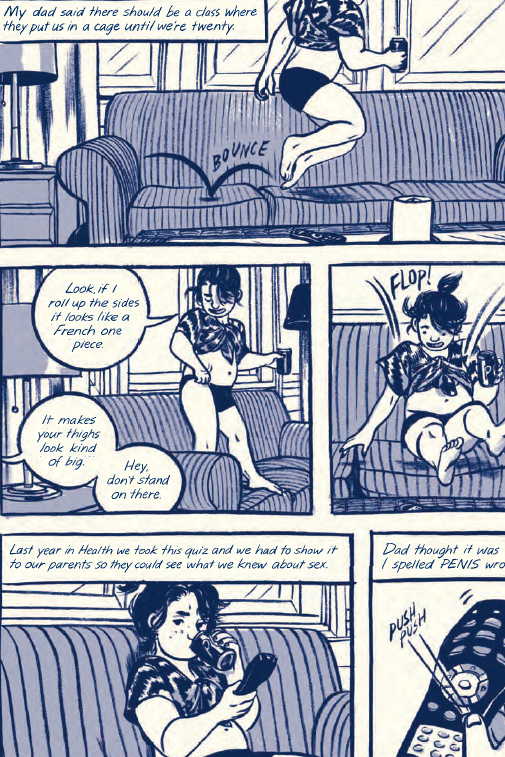 Did you ever think you’d get into comics?
Did you ever think you’d get into comics?
I had no aspirations to work in comics. But I always really liked working on collaborations. I’ve actually done a lot of theatre, and I’ve done a lot of performance art, which for me was like a more accessible version of theatre. So I’ve done a lot of actors work, and a lot of work in sort of feminist collectives and stuff. I was really into the idea of working with another artist than I was in comics per say. But I would say now that I’ve done comics, I think that they’re just an incredible medium for telling stories. The way that stories get told in my experience in comics is that it opens opportunities to tell [them] in so many different angles.
What were some of your ideas for writing this story?
I grew up in Northern Ontario, Canada. And every summer, you went to the cottage. So it was this like solid, integral part of my childhood… When it comes to comics, especially with this one, I thought of the atmosphere. I felt the background would be a good setting for a story. And I’m also kind of obsessed with transitional moments. So for me, the idea of being these young girls, and having this chunk of their lives, and analyzing that part, and all the sort of changes that would happen, even if [those changes] were all going to be during this one summer of their lives… it was something I wanted to show.
Would you say this mirrors any of your life?
Well I use to go to the cottage, but I didn’t have any of those challenges. I used some things as a beginning point, and created something fictional from that. Obviously I was a young girl at the cottage, and I had the fat young friend there too, but the characters are not really that connected to my life. The experiences that they have are not my experiences, aside from the fact that I also did go to Saint Joseph in Huron, which is the park that they go to in the book. Actually, Jillian and I as part of our research (that’s what we call it, “research”), went to Saint Joseph in Huron, went to the cottage, and spent a week in Nova Scotia which is I think one of the best places to write a book.
I think the dialogue is very down to Earth, and very easy to relate to. Is there anything that was hard for you to talk about?
During the initial draft, it was sort of a struggle to write the character of the mother because it’s hard to write somebody who’s not talking about what’s bothering them. And I think that’s so much of what Jillian brought to that character in terms of the details. Even the t-shirts that the mom wears have all these details that kind of build up that character. And we sort of went back and re-edited [her] a lot, because who wants to read about this upset mom who’s just having a bad day? I think that’s like the archetype of the “pissed-off-mom” from like ancient times on. And we wanted to see the layers of that experience. That was a really challenging thing to write, and it ended up being one of the more intriguing stuff. For whatever reason, the writing for Wendy and Rose was for me kind of easy. Their banter was just fun and easy, and it’s hard to write for someone that’s just not pleasant… it’s hard to lovingly write that.
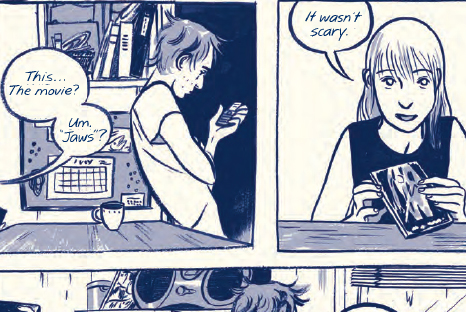
The kids seemed to be able to live in the moment, where the older characters were concerned with other things. How was it to show that dynamic of the two?
My archetype for stuff like that has always been the “Roseanne” show. It’s about the kids, and it’s about the adults. And the problems of the kids are not entirely linked to the adults, but their completely meshed. It’s like you have these people in this microcosm and their like push-pull on each other, where they’re struggling with the same struggles. So for me, I think it’s that kind of step forward from “Skim” to this book. That challenge of really creating a story that’s not just about the kids in this little bubble; to see these layered connections between the kids in the town, these kids in their respective homes, and all other different relationships. To me some of the most interesting scenes are the ones were something of the adults reverberate to the kids; their parents get into a fight, and that trickles down from the parents and then to the kid. And I think that sort of chain reaction is a super interesting one… It’s great to see someone on an adventure, fighting for their family or what have you, but at the same time most of our reality as teenagers is connected to our parents.
It really is interesting seeing these kids’ “bubbles” being formed and shaped by their parents.
It’s like a book about trying to be an adult, just as much for the adults as it is for the kids. These parents are trying to be adults, they’re trying to do the right thing. These teenagers are trying to be adults. And it’s all these varying groups of people that have this notion of what it means to be a grownup, and that depressing challenge of it being out of your reach.
Have you found yourself open to other avenues because of your exposure to graphic novels?
I ended up doing this short film called “Happy Sixteenth Birthday Kevin,” which is a movie about a sixteen year old Goth boy, but the cast is like me and my 30 year old friends. So I did that, because comics showed me how much I love dialogue, and I try to incorporate that as much as I can in the work that I’m doing.
“This One Summer” is available now. You can buy it online, or at your local book store.

By:
Heidi MacDonald,
on 5/7/2015
Blog:
PW -The Beat
(
Login to Add to MyJacketFlap)
JacketFlap tags:
Awards,
Graphic Novels,
Politics,
Controversy,
roz chast,
Richard McGuire,
Top News,
this one summer,
charlie hebdo,
winston rowntree,
Add a tag
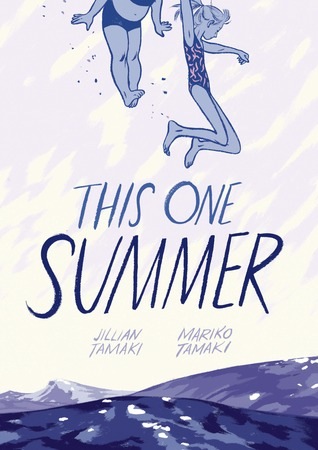
Graphic novels have a lot more prizes than they once did, including literary awards that help validate the medium. Awards season is well upon us, and I’ve been way behind in noting some of the most important.
§ This One Summer by Mariko Tamaki and Jillian Tamaki continued to barnstorm all the honors by winning the Lynd Ward Graphic Novel Prize, perhaps th emost prestigious stand-alone comics prize in the US. The jury cited the book thusly
“This One Summer,” says the jury, “is a beautifully drawn, keenly observed story. It is told with a fluid line and a sensitive eye to the emblematic moments that convey character, time, and place—the surf at night, the sound of flip-flops, a guarded sigh—all at the meandering pace of a summer’s vacation. The Tamakis astutely orchestrate the formal complexities of the graphic novel in the service of an evocative, immersive story. At first blush a coming of age story centered on two young girls, the book belongs equally to all its cast of characters, any of whom feel realized enough to have supported a narrative in their own right. Striking, relatable, and poignant, this graphic novel lingers with readers long after their eyes have left the pages.”
Richard McGuire’s Here was named an Honoree:
Of “Here” the jury says, “Making literal the idiom ‘if these walls could talk…’ McGuire’s ‘Here’ curates the long history of events transpiring in one location. Through the subtle transposition of objects and individuals in a room, the book teaches us that space is defined over time. … Evoking our longing for place, the book performs this cumulative effect for the reader, by layering people, experiences, and events in the context of a single environment.”
The Prize is presented by Penn State and is named after the author of what are now accepted to be early example of standalone graphic novels. (Ward donated his papers to the university.) This year’s jury consisted of Joel D. Priddy, Veronica Hicks, Brandon Hyde, Brent Book and Jonathan E. Abel. MOre information on the prize, the jury and past winners can be found here.
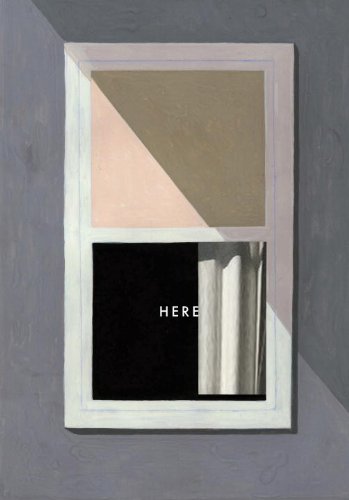
§ The Cartoonist Studio Prize, presented by Slate Magazine and the Center for Cartoon Studies, was also presented a while back. And the graphic novel winners Here by Richard McCguire. (Do you sense a pattern here?) The webcomic prize was won by Winston Rowntree for Watching. The prize comes with a $1000 cash award for each. This year’s jury consisted of Slate Book Review editor Dan Kois; CCS fellow Sophie Yanow; and guest judge, cartoonist Paul Karasik. You can see all the runners up in the above link.
(This result has been sitting in my links for a month; apologies and congratulations to the winners.)
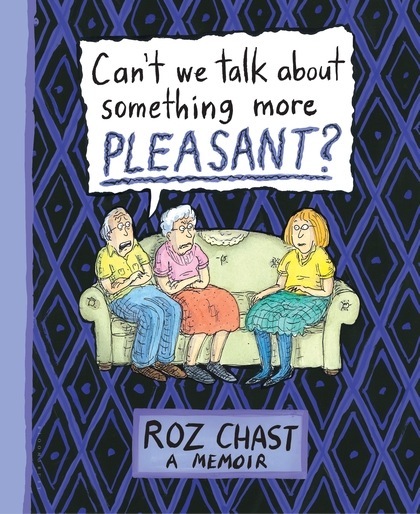
§ While This One Summer and Here have scooped up a bunch of prizes, you must be wondering about the third most honored graphic novel of 2014, Roz Chast’s Can’t We Talk About Something More Pleasant. Well, Chast won the Heinz Award, which is present to six “exceptional Americans, for their creativity and determination in finding solutions to critical issues.” Along with glory, the prize includes $250,000 in cash.
” ‘Floored’ does not begin to describe it,” Chast says of her reaction. “I don’t think I’ve fully absorbed it yet.”

§ As you may have heard, the PEN American Center, a literary organization that promotes free speech, presented French satirical magazine Charlie Hebdo with the PEN/Toni and James C. Goodale Freedom of Expression Courage Award, and all hell broke loose. Many prominent authors protested the award on the grounds that Charlie Hebdo is offensive. You can read many of those comments here. Other authors, including Neil Gaiman, Art Spiegelman, Alison Bechdel and Salmon Rushdie filled the tables at the awards gala vacated by the protesters, and defended Charlie Hebdo as an equal opportunity satirist. You can read all about that here.
While no one in the kerfuffle seems to think that being offensive deserves death, the dissenters felt that giving Charlie Hebdo an award intensified “the anti-Islamic,
anti-Maghreb, anti-Arab sentiments already prevalent in the Western world.”
The pro-Charlie group felt that, as Gaiman put it, “The Charlie Hebdo cartoonists are getting an award for courage. They continued putting out their magazine after the offices were firebombed [in 2011], and the survivors have continued following the murders.”
There aren’t any easy answers here. Terrorists acts are committed to create terror and confusion and turn ordinary people on both sides into radicals. In this goal, at least, the Hebdo attacks were a rousing success.
In the above photo Charlie Hebdo Editor-in-Chief Gerard Biard accepts the award as Alain Mabanckou looks on. AP photo by Beowulf Sheehan

By:
Heidi MacDonald,
on 2/13/2015
Blog:
PW -The Beat
(
Login to Add to MyJacketFlap)
JacketFlap tags:
Breaking News,
mariko tamaki,
Jillian Tamaki,
Skim,
Top News,
this one summer,
Awards,
Interviews,
Cartoonists,
Culture,
First Second,
Add a tag
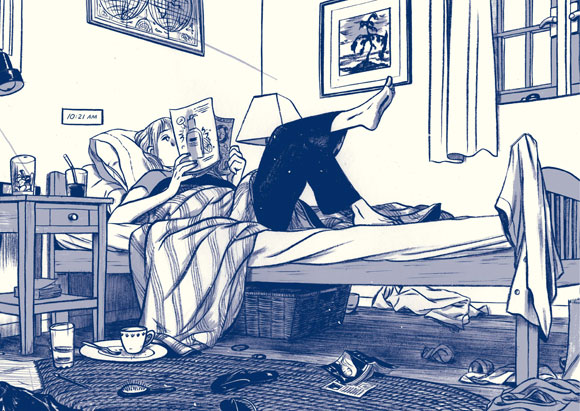
By Harper Harris
Mariko and Jillian Tamaki‘s This One Summer was one of the most highly acclaimed graphic novels of 2014, popping up on a great number of top ten lists as well as winning an Ignatz Award for Best Graphic Novel. To say it was an attention grabber for the already heralded Canadian creators is an understatement.
Just last week, this tale of two childhood friends on the cusp of adolescence was awarded with the prestigious Caldecott Honor, being the first ever graphic novel to do so, along with the Printz Honor (and joins Gene Luen Yang‘s Boxers & Saints as the only other graphic novel to notch that award as well).
Mariko and Jillian were kind enough to join me for a brief Q&A regarding the recent wins and the creative process on this landmark work.
Where were you each when you learned you won the Caldecott Honor? Who called whom?
Jillian Tamaki: I was in bed.
Mariko Tamaki: I think we eventually texted each other about it.
Is there a sense of accomplishment or “I’ve made it” for winning such a prestigious award? Jillian, how does it compare to your Eisner nominations or the Ignatz award that This One Summer also received?
JT: The feeling is one of gratitude. I’ll never felt like “I’ve made it!” until I’m like a hunched-over old person still making things.
Is it more gratifying to get recognition outside of the world of comics, which you’ve done multiple times at this point?
JT: Both are gratifying. Honours granted by librarians are special to me because it represents a knowledgeable, discerning audience that actually works with young people. Honours granted by comics people are special because it means perhaps I am creating something of value within the medium.
Were you relieved that you both got nominated for this award, rather than one or the other as in some past awards?
MT: When one of us gets nominated, I generally see it as a misconception of how graphic novels work. So, yes.
Do awards matter to you? I hope that’s not a weirdly loaded question.
JT: Um, they are nice, yes. Especially when there is money attached, because comics are not lucrative. But I try to not let outside validation determine the micro and macro decisions I make as a creative person.
MT: I guess awards help sales. There are many awesome comics and books out there that have not been nominated, so we’re in good company either way.
This One Summer ended up on many top ten lists for 2014…how does it feel to have one of the most critically acclaimed OGNs of the year among fans? Is it rewarding to see that fans of more mainstream comics are picking up and really enjoying works like yours?
JT: Of course!
As cousins, were you making comics as kids together? When did you decide to pursue sequential art collaboratively?
MT: We lived in distant cities as kids, so there was little comics making. It wasn’t until we made our first mini comic of Skim back in…2006 (?) that we started working together.
How long has this idea been gestating, and how long did it take to actually script and illustrate This One Summer?
JT: It took probably 3 years in total. It took a year of solid work to do the final artwork.
MT: Roughly 6 months to script. Plus changes.
What was your working process on This One Summer? Especially since I understand you don’t live near each other? Was there an initial script first and then an art stage, or was it done in a more section by section basis?
JT: We Skyped a lot. Mariko scripts the dialogue with occasional actions. I do a sketch version. We edit it together, a lot. Then I do the final art.
Where were your individual high and low points in the creative process of this book? Were there any parts that drove you crazy or were difficult to pull off?
JT: The most difficult part was the editing of the sketch phase. As it is with any book, I’m sure.
When I started reading This One Summer, I almost thought it was autobiographical…do either of your personal experiences play a role in the story? Were any of the designs of the characters based on real people?
MT: Nope. There is an actual cottage area that inspired TOS, up in Georgian Bay, Ontario, which I highly recommend people visit.
What is it about the adolescent stage of life that attracts you?
MT: I think most people spend their whole lives trying to figure out how and what to be. As I understand it, it’s not something that stops with adulthood. I think adolescence is interesting because it’s the start of this process. Everything is just that much more on the surface that it is when you’re an adult.
I love how you use Rose and Windy watching horror movies as a kind of metaphor for seeing the world in a more adult way…are you big classic horror movie fans, or how did that aspect of the story develop?
JT: No, I am a chicken. It was easy for me to draw the freaked-out kids.
Your capturing of the pre-teen voice and body language is wonderful…where do you pull that from? Is it based on your memories, or did you embark on any research?
JT: I am fascinated by the storytelling potential of bodies. We are very attuned to what they are communicating and I like to stretch that to effect. Sometimes I get very hung up on tiny details that I’m sure no one will see, but I think it adds up to an overall sensitivity.
MT: I am a chronic eavesdropper. Although the other day on the subway I was pretty sure some kid called me out for doing it so, I’m going to have to learn to be a little less gleeful listening to teenagers talk.
Rose’s family is fraying apart for much of the book. Why was it important to highlight the onset of familial strife, particularly seen from the eyes of a younger character?
MT: Who doesn’t have a little familial strife in their lives these days? It would seem kind of weird to me not to include it, whether writing about kids or adults.
This One Summer is considered to be all-ages, but there are different elements that clearly resonate with adults, which sort of mirrors how Rose is beginning to see the world as well. Who do you feel is the intended audience for the book? Or do you feel like This One Summer is fairly wide-ranging in its appeal?
JT: I only think of a few ideal readers when I work on the book. Some of those readers are real people, some are imagined. They’re usually not young kids. Some are teenagers. Most are my age.
MT: I think a books audience is self selecting. I don’t see a 10 year old reading this book cover to cover. Beyond that I think the idea is to write about not for.
What made First Second your choice of publisher, and why return to them after Skim, specifically?
JT: Groundwood, which published SKIM, put out TOS in Canada, and they have done a wonderful job. First Second made sense in that they had very strong ties to the American library system, in addition to the Macmillan network. But I think it has been excellent having both publishers, as Groundwood can prioritize the Canadian industry. After all, we are Canadian authors and the content is largely Canadian.
How are your next individual projects coming along? Mariko, I understand you’re working on a new YA novel, and Jillian it sounds like you’ve got some more “irons in the fire” in addition to your work on Adventure Time.
JT: My webcomic “SuperMutant Magic Academy” comes out in book form in April from D&Q. Also in April, Youth in Decline is publishing a short story of mine called SexCoven. It will be part of their “Frontier” series.
MT: My next prose YA book, Saving Montgomery Sole, will be released by Roaring Brook/Penguin Canada in Winter 2016.
This One Summer is available through First Second and on sale at your local book retailer

Another win for a graphic novel as Jillian Tamaki won canada’s Governor General Award : for This One Summer in the Children’s Literature Illustrations category. This is a prestigious Canadian literary award, and its the first win for a graphic novel, although cousin Mariko Tamaki was nominated for their previous collaboration, Skim, and Mariko was nominated in the Children’s Literature category this year. Jillian gets the hometown hero treatment from the Edmonton Journal (she’s a native of Calgary.)
It’s the first Governor General nomination for Jillian Tamaki but, strangely, not the first time her work has been nominated. There was controversy back in 2008 when Skim, the first book she created with her cousin, was nominated in the text category but not for illustrations. Tamaki argues that separating illustration and story into two categories for comics does not make a lot of sense, suggesting that it may be time for a separate category for graphic novels.
“It’s the same strange divorce of text and image for this one as well,” Tamaki says. “I think we are both creators of the book. You can’t read a comic without either component, it won’t make sense. It’s something I will always be addressing when talking about the award. But I am completely flattered by the honour and will be sharing the prize with my cousin.”
The National Book Awards ceremony is tonight where Roz Chast’s Can’t We Talk About Something More Pleasant is a finalist. Fingers crossed!
[Via Comics Reporter]
 Little Pink Pup by Johanna Kerby
Little Pink Pup by Johanna Kerby  A Balloon for Isabel by Deborah Underwood
A Balloon for Isabel by Deborah Underwood Citizen Scientists by Loree Griffin Burns
Citizen Scientists by Loree Griffin Burns The Liberation of Gabriel King by K.L. Going
The Liberation of Gabriel King by K.L. Going This One Summer by Mariko Tamaki
This One Summer by Mariko Tamaki


 Frankly, we need this book.
Frankly, we need this book.










Looks amazing. Thanks for the heads-up.
Argh missed the OSU reward. I would absolutely given $300 to go for a private tour.